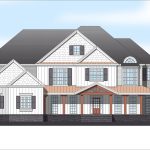Hardie Plank is a brand name of cement board and is made from cement fibers producing strong, heavy boards with deep impressions to mimic the look of real wood boards or shakes.
Vinyl siding is made from PVC, or polyvinyl chloride and mimics the look of wood with impressions in the surface.
When considering siding options for your new home there are many things to consider. You want to first of all love the look of the product but then you’ll want to consider things such as ability to stand up to storms, insulation, the environment, ease of repairs, maintenance, cost and lifespan.
The Elements
When building a new home in Maryland you’ll want to think about our weather. The average weather in Maryland ranges from hot and humid summers with average temperatures of 89 degrees and cold, wet and windy winters with an average temperature of 30 degrees.
Both cement board and vinyl siding provide an R-value of approximately 0.5. Insulated versions are available in both cement board and vinyl to increase your R-value to approximately R-4. The additional insulation will reduce outdoor noises as well as your utility bill.
Cement board is much thicker than vinyl siding, therefore will withstand wind and flying debris hits much better than vinyl siding which is thinner and more prone to sagging, warping and damage in storms. In addition, cement board is resistant to insects and fire.
The Environment
Cement board is made from natural materials and does not emit hazardous chemicals during production. However, being a newer product recycling is not an option as old materials are removed from a home. If put in a landfill, the material is ‘inert,’ meaning it will not emit hazardous gases or chemicals but it will also not break down.
Vinyl siding produces hazardous gases and chemicals while it is being produced and also if it catches fire in the example of a home fire. Since it is a #3 recyclable plastic it can be recycled, however recycling is not available in many facilities.
Repairs & Maintenance
If your siding suffers some damage, cement board is a heavier product and requires precision tools to be properly replaced. Vinyl siding is lighter and easier to remove or replacement.
Cement board should be caulked every 5-10 years. It is recommended to power wash the surface every year to help keep it looking its best.
Vinyl siding should not need any maintenance other than an annual power washing.
Cost
There is no doubt about it, the advantages of cement board come with a cost. Vinyl siding is far less expensive, both in terms of the product itself and labor costs to install it.
Much of the savings is a result of the fact that vinyl is much easier to cut, work with, and install. Cement board is heavier, thus requiring more installers, and it is harder to cut, requiring specialized training and tools to install.
Life Span
Cement board comes with a warranty of 30-50 years, but with proper maintenance can last for 100 years.
Vinyl siding usually comes with a 25-year warranty, but can last anywhere from 20-40 years if maintained properly.
So, which siding is best for your new home?
The right material is dependent upon many factors. For example, if your home will have brick or stone accents, a fiber cement siding will likely provide a more cohesive look given the high detail of texture depth. Some other things to consider:
| Fiber Cement Siding is Better for: | Vinyl is better for: |
| Durability | Cost |
| Longevity | Maintenance & Cleaning |
| Eco-friendliness | Repairs |
| Thickness | |
| Types & Styles |


 Kendal Homes is a home builder in Annapolis, MD. We build homes for discriminating customers throughout central Maryland and the Eastern Shore.
Kendal Homes is a home builder in Annapolis, MD. We build homes for discriminating customers throughout central Maryland and the Eastern Shore.
